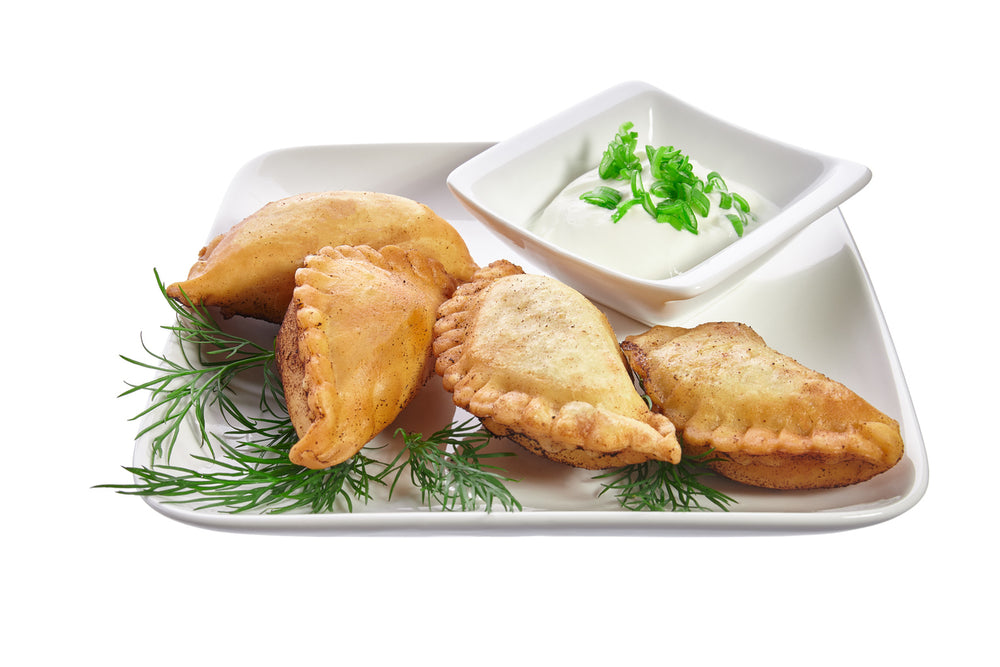Pasty has been a part of British cuisine for many centuries (around the 13th century). Earlier, it was the affluent upper classes and royalty that indulged in them. Rich and varied fillings such as eels, venison, beef, and lamb were flavored with heavy gravies and fruits. Cornish miners and farmers began making pasties only in the 17th and 18th centuries as a quick, scrumptious, and sustaining meal for their work. It was then that the humble Cornish pasty was created.
The wives of Cornish tin miners would make these complete meals to sustain their husbands during their arduous days down the dark, damp mines – because they worked at such depths, they couldn't surface at lunchtime. A typical pasty is just a circle of pasty with a filling of your choice sealed inside and one edge crimped into a thick crust. Using the crust, one could hold the pasty with dirty hands without tainting the food. It was a crucial component of the pasty because arsenic frequently accompanied tin in the ore they were mining, making it safe to consume.
The main ingredients of a Cornish pasty are beef, potato, onion, and swede, which are cooked together in a rich gravy and then packaged separately. In the 17th and 18th centuries, meat was much more expensive and, therefore, less common, so pasties typically contained much more vegetables than they do today. Although it is now common, the presence of a carrot in a pasty used to be a sign of an inferior pasty. There are countless options for fillings, and you can be as creative as your tastes allow.
Here is a Traditional Recipe for a Cornish Handheld Pasty

Ingredients:
For the Pasty-
- 2 ½ cups all-purpose flour
- Half cup cold unsalted butter cut into cubes
- Half cup vegetable shortening or cold lard cut into cubes
- Salt
- 6-8 tablespoons of cold water
For the Filling-
- 450g or 1 pound of beef skirt steak chopped into small cubes
- 2 large potatoes peeled and diced
- 1 onion finely chopped
- 1 small rutabaga/swede peeled and diced
- 1-2 tablespoons butter
- Black pepper
- Salt
Instructions:
Pasty-
- Add a pinch of salt with flour in a large bowl. To it, add the vegetable shortening or lard and cold butter.
- Rub the butter/shortening in the flour with your fingers, or use a pasty cutter. Continue the process till the mixture resembles breadcrumbs.
- Add the cold water a couple of tablespoons at a time and form a dough. Do not overwork the dough.
- Round the dough up like a ball and wrap it in plastic wrap. Store it in the refrigerator for 30 minutes.
Filling-

- Take a bowl and add the beef, potatoes, onion, and rutabaga to it. Season it with pepper and salt as per your taste.
Assemble the Pasties-
- The next step is to preheat the oven to 375°F or 190°C.
- Make four equal portions of the pasty dough.
- Flour a surface and roll out each portion into a circle of about 8-9 inches.
- Place a portion of the prepared filling on one half of each pasty circle and leaven a border around the edge.
- Add a little butter on top of the filling in each pasty.
- Fold the other half of the pasty over the filling to create a semicircle shape.
- Crimp the pasty edges to seal the pasty. An easier way to do it is to use a fork to press the edges down. (A traditional Cornish pasty should always be crimped. It should be crimped to form a 'D' shape.)
*Adding butter to the filling is optional. Traditionally, the pasty was closed without the butter, but when added, it does enhance the flavour of the pasty.
Baking-

- Take a baking tray, line it with parchment paper and keep the pasties on it. You can brush the pasties with beaten eggs for a glossy look, but this is optional. Bake the pasties for 45-60 minutes or till they are golden brown.
Serve hot or at room temperature.
This recipe we have mentioned is that of a traditional Cornish hand-held pasty. In the present day, Cornish pasties have a variety of fillings, including cheese, chicken, vegetables, etc. While all flavours and varieties are appreciated, most like to prepare and consume Cornish pasties just as it was back in the olden days. It can, in fact, be termed as a robust pasty that is not just delicious but healthy and filling, too.
Some Tips to Make an Authentic Cornish Pasty

- For an authentic Cornish pasty, the stuffing should comprise of 25% vegetables and 12.5% meat.
- The vegetable filling should be potato, onion, and rutabaga/swede, while the meat should be beef.
- When the filling is added to the pasty, these ingredients should remain raw before they are baked. This allows the juices from the meat and vegetables to mix together and seep into the pasty, too. Overall, it enhances the taste of the pasty.
- The water used to mix the dough and the shortening or lard should be cold. This allows the creation of a flaky but soft crust.
- All the ingredients should be diced equally for a nice look, even cooking, and consistent texture.
- Make a small slit over the prepared pasties before baking them in the oven. This helps the steam to escape and prevents the pasty from getting soggy.
- While authentic Cornish pasties are made from suet pasty, shortcrust or puff pasty may also be used as long as they are robust.
You will have made a good Cornish pasty if it falls and doesn't break open and spill the contents.


 Christmas 2025
Christmas 2025
 Frozen Food
Frozen Food
 Baking
Baking
 Beans, Peas, Soups & Tins
Beans, Peas, Soups & Tins
 Biscuits, Crackers & Cookies
Biscuits, Crackers & Cookies
 Candy / Sweets
Candy / Sweets
 Crisps & Snacks
Crisps & Snacks
 Chemist / Pharmacy
Chemist / Pharmacy
 Desserts
Desserts
 Gravy, Stock & Paste
Gravy, Stock & Paste
 Haggis
Haggis
 Indian Sauces, Paste and Pickle
Indian Sauces, Paste and Pickle
 Jams & Preserves
Jams & Preserves
 Poppy Appeal
Poppy Appeal
 Pot Noodles & Super Noodles
Pot Noodles & Super Noodles
 Scone Mix
Scone Mix
 Gluten-Free / Free From
Gluten-Free / Free From
 Tea Accessories
Tea Accessories
 Teapot & Tea sets
Teapot & Tea sets
 Tea For One
Tea For One
 Sugar & Creamer
Sugar & Creamer
 Tableware
Tableware
 Serveware
Serveware
 Plates & Trays
Plates & Trays
 Bowls
Bowls
 Cups & Saucers
Cups & Saucers
 Mugs
Mugs
 Silverware
Silverware
 Dinnerware - Accessories
Dinnerware - Accessories
 Dinnerware - For Pets
Dinnerware - For Pets
 Victoria Eggs - Hand-Drawn UK Homeware
Victoria Eggs - Hand-Drawn UK Homeware
 Jewelry & Accessories
Jewelry & Accessories
 Sale
Sale
 Christmas Gifts
Christmas Gifts

